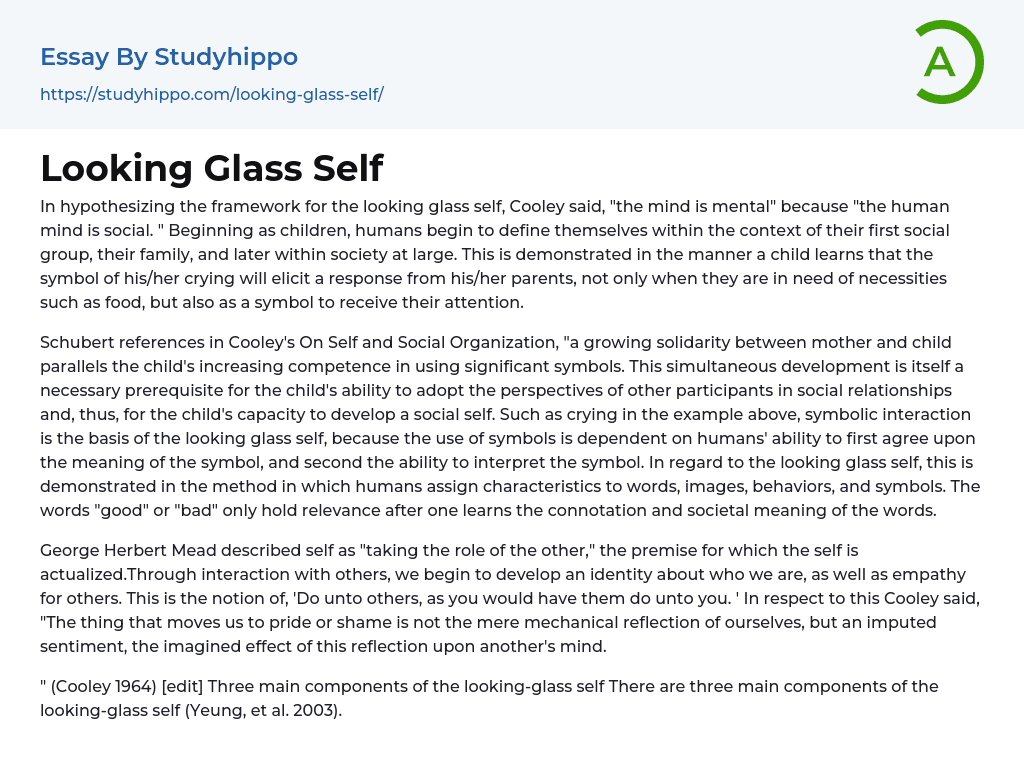In hypothesizing the framework for the looking glass self, Cooley said, "the mind is mental" because "the human mind is social. " Beginning as children, humans begin to define themselves within the context of their first social group, their family, and later within society at large. This is demonstrated in the manner a child learns that the symbol of his/her crying will elicit a response from his/her parents, not only when they are in need of necessities such as food, but also as a symbol to receive their attention.
Schubert references in Cooley's On Self and Social Organization, "a growing solidarity between mother and child parallels the child's increasing competence in using significant symbols. This simultaneous development is itself a necessary prerequisite for the child's ability to adopt the perspectives of other participants
...in social relationships and, thus, for the child's capacity to develop a social self. Such as crying in the example above, symbolic interaction is the basis of the looking glass self, because the use of symbols is dependent on humans' ability to first agree upon the meaning of the symbol, and second the ability to interpret the symbol. In regard to the looking glass self, this is demonstrated in the method in which humans assign characteristics to words, images, behaviors, and symbols. The words "good" or "bad" only hold relevance after one learns the connotation and societal meaning of the words.
George Herbert Mead described self as "taking the role of the other," the premise for which the self is actualized.Through interaction with others, we begin to develop an identity about who we are, as well as empathy for others. This is the
notion of, 'Do unto others, as you would have them do unto you. ' In respect to this Cooley said, "The thing that moves us to pride or shame is not the mere mechanical reflection of ourselves, but an imputed sentiment, the imagined effect of this reflection upon another's mind.
" (Cooley 1964) [edit] Three main components of the looking-glass self There are three main components of the looking-glass self (Yeung, et al. 2003).
- Unconscious Mind essays
- Age Of Enlightenment essays
- Ethos essays
- Time essays
- Acceptance essays
- Meaning Of Life essays
- Reality essays
- Natural Law essays
- Political Philosophy essays
- Utilitarianism essays
- Existence essays
- Free Will essays
- Good And Evil essays
- Confucianism essays
- Relativism essays
- Conscience essays
- Environmentalism essays
- Empiricism essays
- Epistemology essays
- Ethics essays
- Existentialism essays
- Human Nature essays
- Individualism essays
- Metaphysics essays
- Philosophy Of Life essays
- Transcendentalism essays
- Truth essays
- Destiny essays
- Determinism essays
- Fate essays
- Functionalism essays
- Philosophers essays
- Pragmatism essays
- Future essays
- Child Observation essays
- Critical Reflection essays
- Teaching Philosophy essays
- Personal Philosophy essays
- Action Speak Louder Than Words essays
- Can Money Buy Happiness essays
- Values of Life essays
- Ethical dilemma essays
- Normative Ethics essays
- Virtue Ethics essays
- Belief essays
- Deontology essays
- Moral essays
- Virtue essays
- Work Ethic essays
- Henry David Thoreau essays




